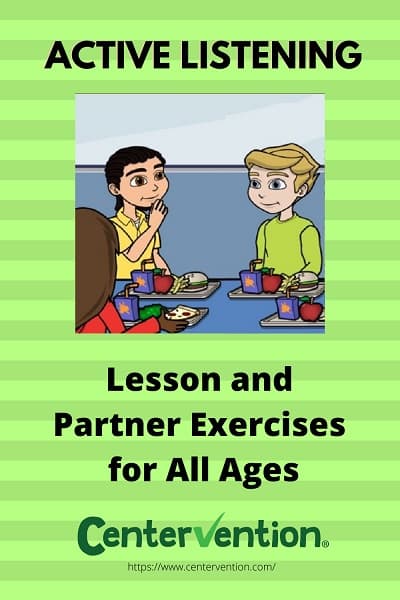These simple active listening exercises help students focus on what is being said and to share their feelings about being truly heard.
Active listening, which includes eye contact, appropriate body position and language, and the acts of asking questions, summarizing, and not interrupting, is an essential skill for making new friends, understanding information, and communicating effectively.
Whether students are building relationships with friends or learning a new concept from teachers, they must engage in good listening in order to be successful. In fact, the benefits of active listening extend beyond the classroom, and is a quality many employers seek when interviewing candidates.
Recommended Grade Level: Elementary, Middle, and High
SEL Skill(s): Communication
Duration: 30 minutes
Materials:
- Chart Paper and Marker
- Active Listening Partner Cards (Available when logged in to Centervention educator account)
Educator Instructions for Active Listening Exercises
Small Group Active Listening Exercises
Gather students in a common area and ask one student to come forward. Tell students that when we listen with our ears, eyes and bodies it’s called active listening.
- Ask the student to tell you what their favorite meal is. As they speak, demonstrate good active listening behaviors including body language and acknowledgement (“Mmhmm” or nodding).
- When the student stops speaking, restate what they said (“I heard you say your favorite meal includes…”) and then ask a follow-up question (“What you would have to drink with that,” or “What would you have for dessert?”, etc.).
- Allow the student to answer your question, then restate the details (“First you told me your favorite meal is a hamburger and fries, then you also said you like it with a lemonade and ice cream, is that right?”).
- After the student clarifies, ask the group whether they thought you were being a good listener and how they could tell.
Next tell the group you will show what it looks like when someone is not being a good listener.
- Ask the same student again to describe their favorite dinner, but this time turn away, show poor eye contact, and interrupt the student mid-sentence.
- Have the group describe the differences in your listening behavior.
Partner Active Listening Exercise
- Split students into pairs and give each student an age-appropriate question card.
- Remind the group how you listened when the student described their favorite meal.
- Set a 2 minute timer and allow the one partner to ask the second partner the question on their card. The first partner should practice the active listening process of listen, retell, ask, retell.
- After the 2 minutes, have partners switch roles, allowing the second partner to ask and listen as the first partner speaks.
- Call on students to restate what they learned about their partner and to share what it feels like to be truly heard.
